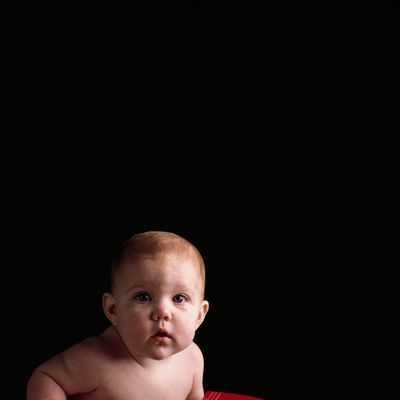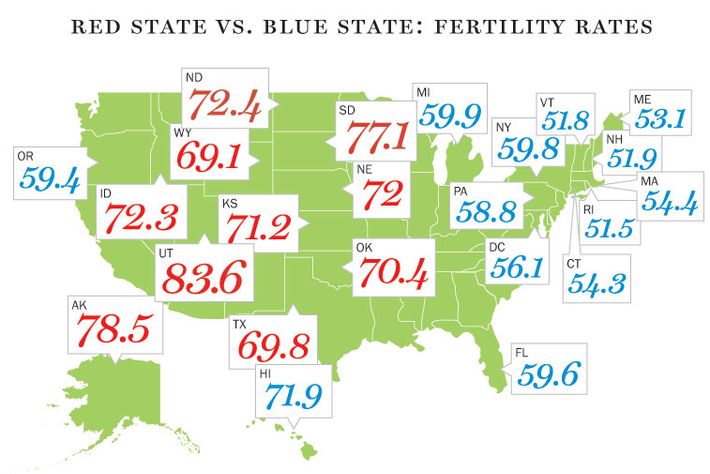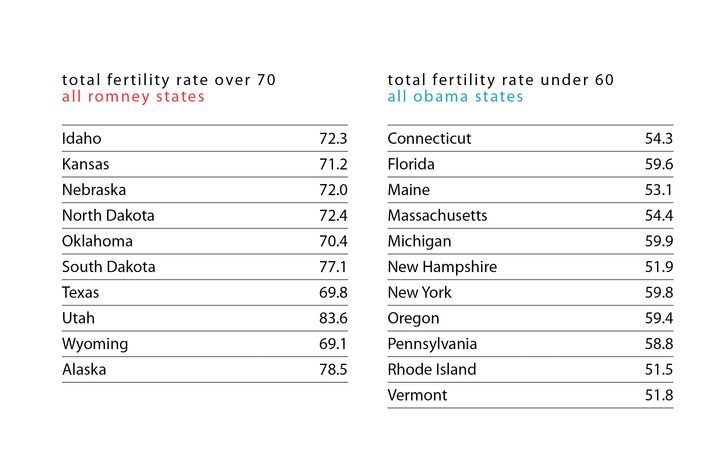
Grumbling GOP commentators and reveling feminists finally agree on something: This was the year when single ladies helped to deck the White House in blue. But another, even more powerful feminine factor was at play in this election, as it has been in races past: Almost invisibly over the past decade, family size in America has emerged as our deepest political dividing line.

Stunningly, the postponement of marriage and parenting — the factors that shrink the birth rate — is the very best predictor of a person’s politics in the United States, over even income and education levels, a Belgian demographer named Ron Lesthaeghe has discovered. Larger family size in America correlates to early marriage and childbirth, lower women’s employment, and opposition to gay rights — all social factors that lead voters to see red. The converse, according to futurist Joel Kotkin, marks “the rise of post-familialism,” overturning the notion that a woman’s life requires a wedding dress and at least two kids to dutifully rear. David Brooks devoted a column to this report Friday, and his reaction demonstrates the red blood spilling over our shift to a freer attitude toward life and family choices. “People are not better off when they are given maximum personal freedom to do what they want,” Brooks wrote. “They’re better off when they are enshrouded in commitments that transcend personal choice — commitments to family, God, craft and country.”
Americans are increasingly rejecting traditional conservative power structures — the old models of authoritarian Church and State — as Europeans have for decades. “It’s amazing how once you get rid of obedience to the authority of institutions so much simply falls away,” Lesthaeghe told me over coffee at a conference in Vienna last year. He went on to predict that, despite the GOP backlash against it, American’s adaptation toward a more liberal way of living could only encourage a political shift to the left. You could see this destiny manifested in last Tuesday’s vote: in Maine, for marriage equality; in New Hampshire, for a completely woman-governed state for the first time in American history; in Massachusetts, for progressive candidate Elizabeth Warren; and so on.

Yet, for all those social measures on the 2012 ballot, our near-continental divide of politics and fertility was even more distinct during the Bush era, before the New York Times had added the “celebrations” category to its still-hetero wedding listings. Despite the rampant conservatism of that time, there was no rape caucus to combat; the Evangelical block was country strong. In the 2004 presidential election, while swift boats sailed cross the headlines, fertility rates in states that voted for Bush were 12 percent higher than they were in states that picked Kerry. When Lesthaeghe studied the map county by county, he found the link between family size and political leaning became even stronger. This morning, he sent me an e-mail to say he still has to check the county results from this election, but once again, he expects the same granular correlation, “no surprises, judging from the state-level results.”
Since then, the polarization has weakened slightly. While voting in 2008 fell clearly along fertility lines, demographer Phillip Morgan found in examining the fertility of “MSNBC v. Fox News” audiences liberals’ post-Obama glow engendered the optimism needed to have a kid in a crushing recession. Conversely, a red outlook no longer meant a rosy one to the snarling cynics at Fox: Subsequently, conservatives began to consider larger, and therefore more expensive, families to be an increasing impossibility. Low birth rates aren’t really about freedom but fear, Morgan believes. “People put off having kids,” which leads to sinking fertility, he told me, “because they’re really frightened about the future.”
With liberal fertility on the rise, the predictive power of family size finds itself waning. As our demographics change, that county-by-county correlation that was so absolute ten years ago is beginning to yield to a purple reign. Celinda Lake, one of the Democratic party’s leading pollsters and strategists, who predicted the single ladies swing well before the exit polls, told me our future partisan fertility map is being redrawn. She says that as birth rates rise amongst women of color who vote consistently Democrat, the states working blue may make a radical turn to become our most fertile ones.
“We’re on the verge of a dramatic shift. It will be a different conversation ten years from now,” Lake told me, estimating that the predictive power of fertility will last until 2020, but not much longer. And with an increasingly liberal bloc of mothers — like the ones who renewed Obama’s lease on the Oval Office in massive numbers — perhaps it’s not impossible to imagine electing a woman who opted for her own one-child family so she could dedicate herself to a world outside the home. A low-fertility politic doesn’t mean no fertility; it doesn’t mean refusing motherhood. Rather, it supports a woman’s choice to “shut it down,” to borrow a recent turn of phrase. It speaks to an ethic of an inclusive, extra-domestic life.
Broadminded is a weekly column about gender and women’s issues, written in alternating weeks by Alissa Quart and Lauren Sandler.
Fertility data: CDC, “Births: Preliminary Data for 2011.”




